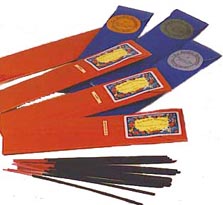

Today, perfumes for the home or "house perfumes" are in demand and Le Jardin Retrouvé, true to its vocation of returning to the original sources of perfumery, has added Scented Candles to its collection.
The Jardin Retrouvé scented candles, housed in metal boxes (patented), have been perfumed with fragrances specially created for this purpose. The perfume is released when the candle is lit and fills the air until its last dying flicker. Each candle burns for more than 50 fragrant hours.
Only specific raw materiels of natural origin that will release a perfume when burning are used by our Perfumer for these fragrances. Flowery scents are best adapted to this purpose. Thus, to ensure that the perfume circulates in the atmosphere, the ingredients for each of our candle perfumes have been chosen with the greatest care.
The Chèvrefeuille (Honeysuckle) and Jasmin (Jasmine), light and lively, reproduce as closely as possible the fragrances of these flowers. Tubéreuse (Tuberose) and Rose Thé (Tearose), more "warm" and "rich" are created to perfume the air with flowery, strong, long-lasting notes. Cuir de Russie (Russian leather), a complex composition, very "rich" and powerful, containing ingredients evoking the smell of leather in a rather "impressionistic" interpretation. It is constructed around harmonies of AMBER - SPICE - WOOD, with a light FLORAL touch which "rounds off" the composition and gives it a stronger diffusing power.
| Chèvrefeuille (Honeysuckle)
|
Cuir de Russie (Russian Leather)
|
| Jasmin (Jasmine)
|
Lys (Lily)
|
| Rose Thé (Tearose)
|
Tubéreuse (Tuberose)
|
[Top]
Perfume has existed in the history of mankind since antiquity. In its orginal form it was a house perfume, to use a term that is à la mode today. What does "perfume" really mean ? It is derived from the Latin "per fumare" - by smoke. Smoke was originally the conveyor of perfume.
People have always wanted to create a fragrant, agreeable and pleasant atmosphere and to do so, all ancient civilisations burnt plants which gave off a pleasant odour. They burnt perfumes as offerings to divinities. What is the incense of our churches, if not a "house perfume"?
After using perfume for religious reasons, people continued using them to fill the air with fragrance even for festivities that were more secular.
In India, where perfume has conserved its original signification to a certain extent until today, hundreds of millions of incense sticks or "Agarbathis" are burnt throughout the year and these Agarbathis have become famous the world over. It is in India that you find, in the palaces of the ancient Mogul emperors in Delhi and Agra, ceramic channels traversing the halls, in which flowed water with freshly-plucked jasmine and rose petals. Ancient perfume-burners bear witness that civilisations of every epoch strived to create a sweet-smelling atmosphere, appealing to the senses, and give proof of their highly-refined tastes.
 |
The Bâtonnets à Brûler of the Jardin Retrouvé are an interpretation of the Indian Agarbathis, perfumed with scents from our own collection of Eaux de Parfum such as Chèvrefeuille (Honeysuckle), Jasmin (Jasmine), Eau Pour Homme Vétyver (Vetyver), Cuir de Russie (Russian Leather) and Sandalwood. While burning their sweet-smelling and odorous smoke creates a lightly-scented and pleasing atmosphere. [Top] |